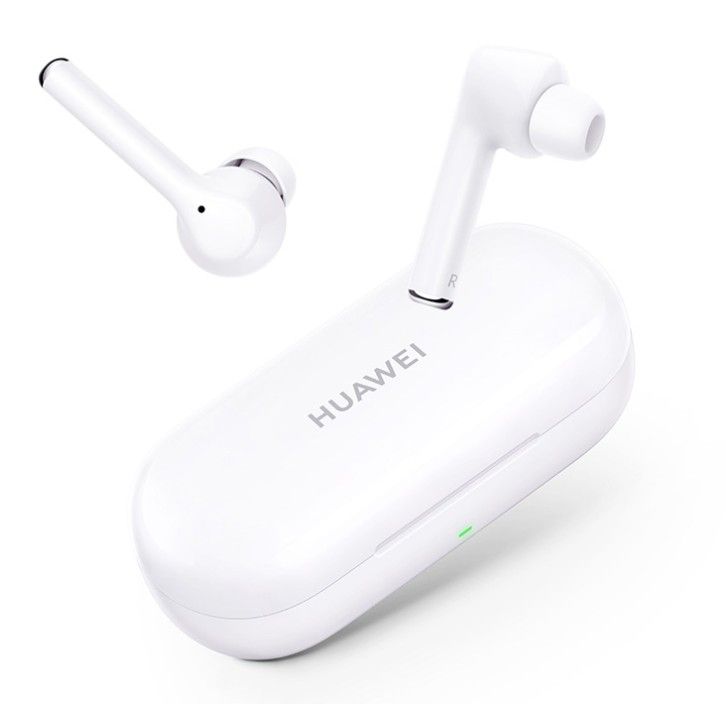Late last year at the IFA trade show in Berlin, Huawei announced the FreeBuds 3 — its latest truly wireless earbuds featuring active noise cancellation, wireless charging, bone conduction for voice, and 4 hours of music playback (up to 20 hours with the case). The FreeBuds 3 packed in Huawei’s HiSilicon Kirin A1 chipset, which enabled dual-mode Bluetooth 5.1 and BE+LE 5.1 connectivity, allowing the earbuds to deliver stereo sound with latencies as low as 190ms. Adding on to its FreeBuds lineup of truly wireless earbuds, Huawei has now announced the FreeBuds 3i — a more affordable version of last year’s FreeBuds 3.
Huawei FreeBuds 3 Specifications
| Specifications | Huawei FreeBuds 3i |
|---|---|
| Dimensions & Weight |
|
| Type |
|
| Noise Cancellation |
|
| Charging Time |
|
| Battery Capacity |
|
| Drivers | 10mm |
| Bluetooth | Bluetooth v5.0, supports A2DP 1.3, HFP 1.6, AVRCP 1.5 |
| Charging case | Wired: USB Type-C |
| Color | Ceramic White |
| Pop-open connectivity | Supported for smartphones running EMUI 10 or above |
The new FreeBuds 3i features a design that’s reminiscent of the FreeBuds Lite, which were launched alongside the Huawei P30 series in March last year. The earbuds also offer active noise cancellation and feature 10mm dynamic drivers for high-quality audio output.


For voice functions, the FreeBuds 3i feature two outward-facing microphones to pick up your voice among environmental noises and one inward-facing microphone that receives your voice conducted inside your ears to improve call quality. The earbuds support tap gestures (long-tap to toggle ANC and double-tap to toggle music or answer/end calls) and can automatically pause playback when the earbuds are taken out and resume when they’re reinserted into your ears.

In terms of battery life, the FreeBuds 3i boast of 3.5hours of music playback, which can be extended up to 14.5hours with the charging case. In comparison with the more premium FreeBuds 3, the new FreeBuds 3i are almost half the price and will be available in the UK for £90. However, Huawei has cut a few corners to reach this price segment and the FreeBuds 3i offer a lower battery life and no wireless charging. The earbuds are also relatively bigger and heavier, have smaller dynamic drivers, and don’t include the Kirin A1 chipset.


Along with the FreeBuds 3i, Huawei’s sub-brand Honor has also released its own truly wireless earbuds in the European market. The Honor Magic Earbuds, which were launched earlier this year in February, seem identical to the Huawei FreeBuds 3i and offer hybrid active noise canceling and adaptive noise canceling. The earbuds are also equipped with 10mm drivers and feature a 37mAh battery, with an additional 410mAh available on the charging case. The Magic Earbuds offer all the same features as the Huawei FreeBuds 3i.
Honor Magic Earbuds Specifications
| Specifications | Honor Magic Earbuds |
|---|---|
| Dimensions & Weight |
|
| Type |
|
| Noise Cancellation |
|
| Charging Time |
|
| Battery Capacity |
|
| Drivers | 10mm |
| Bluetooth | Bluetooth v5.0, supports A2DP 1.3, HFP 1.6, AVRCP 1.5 |
| Charging case | Wired: USB Type-C |
| Color | Ceramic White |
| Pop-open connectivity | Supported for smartphones running EMUI 10 or above |
The Honor Magic Earbuds are available starting today on HIHONOR.COM in France, the Netherlands, Germany, and Italy for €99. The earbuds will also go on sale in the UK on May 21st for £99 and will be available in two color options — Pearl White and Robin Egg Blue.
The post The Huawei FreeBuds 3i and Honor Magic Earbuds are affordable true wireless earbuds with active noise cancellation appeared first on xda-developers.
from xda-developers https://ift.tt/2YFyo9o
via IFTTT






